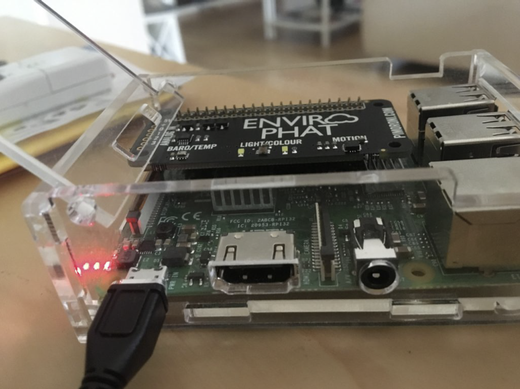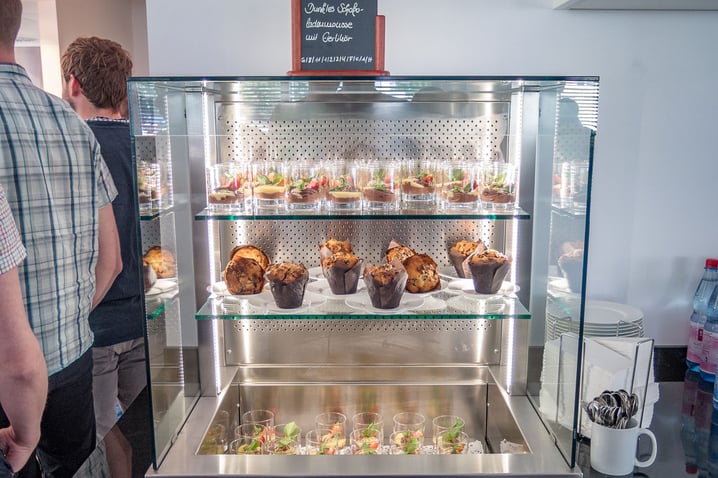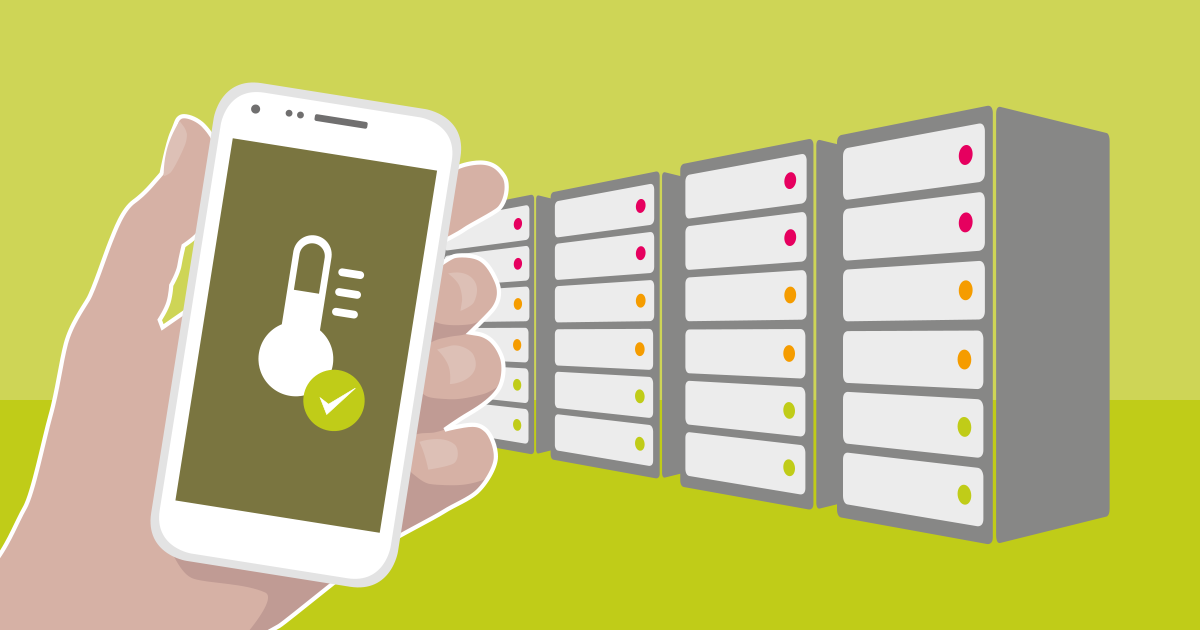How to Avoid Heat-Related Failures and Problems
If you’re running a data center / server room in your company, you will probably already be monitoring the temperature in there to avoid issues from overheating. But there are also other places and things in your office building where monitoring the temperature can help you to avoid negative effects of high temperatures.
1. Data Center / Server Room
No matter whether you’re running a huge data center or a server room with just a few switches and servers: if your switches and servers matter (and I’m sure they do!), you must monitor the room temperature. When it comes to overheating, servers shut down and you can lose important data, or, even worse, it causes physical defects and even bigger losses of data and money.
Of course, you can just rely on the machines’ temperature information, which is quite easy to monitor using standard SNMP or WMI requests with your IT-monitoring tool. But if your server’s temperature reaches unusual peaks, it is often already too late and cooling the room down will not be so easy. Monitoring the room temperature will give a much earlier indication if something is going wrong, so you have enough time to react early and avoid serious problems.
Btw: High temperature does not only cause outages, it also means high stress for the materials. ELKOs (electrolytic capacitors) are part of every electronic device and ELKOs suffer when it gets hot: every 10°C / 50°F more halve an ELKO’s lifetime. Keeping temperature low can save you a lot of money over a longer period. Of course, you must also calculate with the cooling costs, so it’s all about finding the right compromise. Therefore, it’s important to monitor and to store the monitoring data for a long-term analysis.
How to monitor your server room temperature?
There are many vendors, like Kentix, who offer physical sensors for measuring temperature, but also humidity and other environmental conditions. Usually these devices support SNMP, so it’s easy to integrate them into overall IT-monitoring as most standard monitoring solutions support SNMP. Some tools, like PRTG Network Monitor, come with predefined device templates so they can monitor many environmental sensors out of the box. At the Paessler blog, you can also find a guide how to build your own budget temperature sensor based on a Raspberry Pi.

Torsten from our Tech Support team shows how to build an environmental sensor on a budget
If you’re monitoring your air conditioning, it’s not only the discharge temperature that matters, but also the intake temperature. Rising intake temperature is a first indicator for upcoming problems, as it can lead to an overstressed air conditioning which results in failures.
What to do if it gets hot?
If your monitoring tells you that a server room’s temperature is rising, the first thing to do is check what’s going on. Maybe it’s just a hot day and a slightly higher temperature could be tolerated. If that’s not the case and serious problems arise, like a failure of the air conditioning or an extremely hot day, you must react. If it’s just a failure of the air conditioning on a freezing cold winter day, then you’re lucky: all you must do is get the warm air out of your server room and cold air into it using fans, or at least open doors and windows. If that’s not an option because it’s a hot summer day, but you must bridge the time until the air conditioning is running again, or night time comes and it gets cooler, then you must start turning off devices. Of course, that will firstly be the ones producing lots of heat, but also those which are not that important to your business processes. It’s all about finding the right balance then.
2. Don’t Forget the Broom Closet!
What? Why should I monitor the broom closet’s temperature? Maybe because you got some switches in there! Often single switches for distributing traffic on a floor or a certain part of a building are placed in a room that’s not used that often – like a broom closet. And as it’s just one switch or maybe two or three devices in total, there is no air conditioning in that room. Usually the risk of overheating isn’t that big as there aren’t that many heat-producing devices in there, but on a warm summer day it can become quite hot in such a small room with a big switch in it. And even if it probably would not cause failures, it’s still about the stress for the hardware and its lifetime.
Using modern devices usually is a first step to avoid this, as most modern (and high end) devices have higher quality components which endure higher temperatures. But nevertheless, you should monitor the room temperature to make sure that you are alerted in case it becomes too hot. You could use a budget solution as from the link above, or just a common consumer device like the NetAtmo series, which can easily be integrated into a monitoring solution such as PRTG. If the temperature becomes too high, usually it will be sufficient to open the closet’s door and maybe use a fan. If that doesn’t solve the problem, then you will probably have to shut down some devices before it comes to serious damage.
3. Is it Warm Outside?
Sure, usually you will know if it’s a cold winter or a hot summer day. However, sometimes, if you’re working in an environment with air conditioning, you might not have realized that the outside temperature has become really high. Even if you know that it’s going to be the hottest day of the year, you might want to use the morning air to cool down your office and data center, and then switch when it becomes hot. Monitoring outdoor temperature will give you an additional hint when the intake temperature for your server room’s air conditioning will become higher than usual. That again means that it might come to an overload of your air conditioning. Knowing this in time, you might be able to shut down some not so important devices to take some load from the air conditioning and perhaps also raise the discharge temperature a bit so the air conditioning can still handle the heat.
4. Hot Meals, Cold Groceries
Does your company have a cafeteria? Lucky you, so you probably get great food for little money. Usually a cafeteria must store food in refrigerators and maybe also freezers. Cooling outages can cause lots of rotten food, and depending on your company’s size, this can mean a serious amount of lost money. Also, here it’s very easy: you can use the ‘homemade’ budget device from above or one of the relatively cheap NetAtmo devices. You can use this in combination with a classic IT-monitoring solution like PRTG to monitor the temperature of your fridges and freezers. If your monitoring solution supports a granular alerting management with escalation options (like PRTG does), you can have an email-alert sent to the person in charge of your cafeteria, if monitoring data indicates that something’s going wrong. And you could also have a push notification sent to the mobile phones of your entire IT-team if the problem still exists two hours later.

Don’t forget to keep an eye on your fridge's temperature.
5. Hot Seat at Your Colleague’s Workplace?
Have you thought about monitoring the temperature in your office? It’s more important than you might think. Knowing how warm it is in each room and office gives you the advantage of saving money for heating and cooling, but also provides a better climate for your colleagues. If you find big variations in room temperature, the reason might be bad ventilation habits, like turning the heating on to max and then opening the window to lower temperature. You might want to talk to your colleagues and explain to them how to regulate temperature in the right way. Measuring temperature using a long-term perspective may help you to decide whether it makes sense to invest in air conditioning, additional heating, or maybe a pool.
And finally: if it gets very warm in your office, reaching something like 30°C / 85°F, then give your management a little hint – proposing a heat break with some cool drinks or ice cream for everybody. That would not solve the heat-problem, but probably help a little bit in enduring it. ;)
Conclusion
I’m sure you have some more ideas on where temperature monitoring makes sense in your office, but maybe this article gave you some hints? Let us know if you have any tips to share, and don’t hesitate to contact us, if you have any questions regarding temperature monitoring in your company.
 Published by
Published by 




.jpg)






